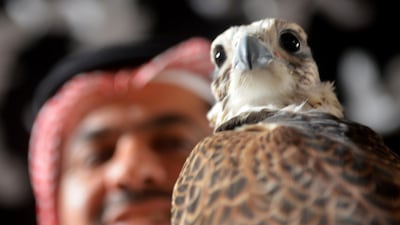In the past, the conservation community and devotees of falconry viewed one another with a degree of suspicion at best and at worst, open hostility. But there have been important steps made recently in a growing collaboration between the two groups. Earlier this year, I attended a conference in Abu Dhabi called Summit for the Flyways, which brought together both conservation organisations such as BirdLife International and the Ornithological Society of the Middle East, the Caucasus and Central Asia, and bodies related to falconry, including the Abu Dhabi-based International Fund for Houbara Conservation. The meeting, supported by the UN-affiliated Convention on the Conservation of Migratory Species and the Environment Agency-Abu Dhabi, examined threats to migratory birds moving between Africa, Europe and Asia and discussed initiatives to reduce those threats.
The conflict between the two camps has been fading as both have recognised that there is scope to work together and that the two passions are not mutually exclusive. After all, there can be no long-term future for falconry if the survival of wild falcons and their favoured prey, the houbara, is in danger. At the same time, the conservation of the habitats in which these species live has a beneficial effect on all other creatures that live there. There are both shared interests and potential conflicts of interest and the identification of a happy medium is, surely, the way forward.
As a boy growing in the English countryside, I developed a profound interest in the environment and the wildlife around me. With a father who was a top horticultural writer and a mother who taught biology, that was, perhaps, not surprising. For years, I used to shoot as well, deriving satisfaction not so much from the quarry as from the gradually honed ability to observe wildlife around me. I no longer shoot but I’ve never found it difficult to combine passion for the environment with support for some forms of country sports, field sports or blood sports, whatever you might call them.
As a birdwatcher in the UAE, I have also learned to understand the passion for falconry shared by many Emiratis. It has been fascinating, therefore, to observe how the country has helped to bring together the two sides of the debate between conservationists and falconers.
That process began with the first International Conference on Falconry and Conservation, held in Abu Dhabi in December 1976 under the patronage of the late Sheikh Zayed, a man once described as "a conservationist before the term became fashionable". The event, which I attended, brought falconers into the mainstream of global conservation initiatives for the first time.
_________________________
Read more from Peter Hellyer:
Remember the fallen, a century after the First World War
The UAE's wetlands are a national treasure
A man in a hurry: how Baba Zayed's early years as Ruler of Abu Dhabi shaped his vision for the UAE
_________________________
Recognising that populations of wild houbara were declining, not only because of falconry but also because of major habitat changes, Sheikh Zayed encouraged local falconers to limit the number of houbaras they caught and to stop hunting in the breeding season. He launched programmes to breed the species in captivity which, after years of trial and error, now see tens of thousands of birds being bred and released each year.
At the same time, he sought to tackle threats to falcon populations triggered by capturing birds from the wild for use in falconry. One initiative was the launch more than 20 years ago of the Sheikh Zayed Falcon Release Programme. It meant birds caught in the wild were released at the end of each hunting season to re-integrate into their natural habitat. In the UAE, that has now become standard practice.
Another initiative was the development of captive breeding programmes of species like saker and peregrine to reduce the demand for wild birds. Such programmes can now be found not only in more temperate climates like the UK but also here in the UAE, such as the project run by Mohammed Al Kamda in Dubai, which received attention in The National last week.
There remain, of course, areas of conflict between conservationists and followers of falconry and other field sports. Falcons caught illegally in Britain and elsewhere are still exported to the Middle East. Suspicious deaths of another bird of prey – the hen harrier – on hunting estates in Britain indicate that members of the shooting community are still targeting these endangered birds. More needs to be done to eradicate these practices.
One key initiative to emerge from the flyways summit was the launch of the new Mohamed bin Zayed Raptor Conservation Fund supporting initiatives protecting endangered birds of prey globally, both falcons and other species. Through such means, old rivalries are being laid to rest as conservationists and supporters of field sports like falconry come together in pursuit of the common goal of protecting endangered wildlife.
Peter Hellyer is a consultant specialising in the UAE's history and culture


